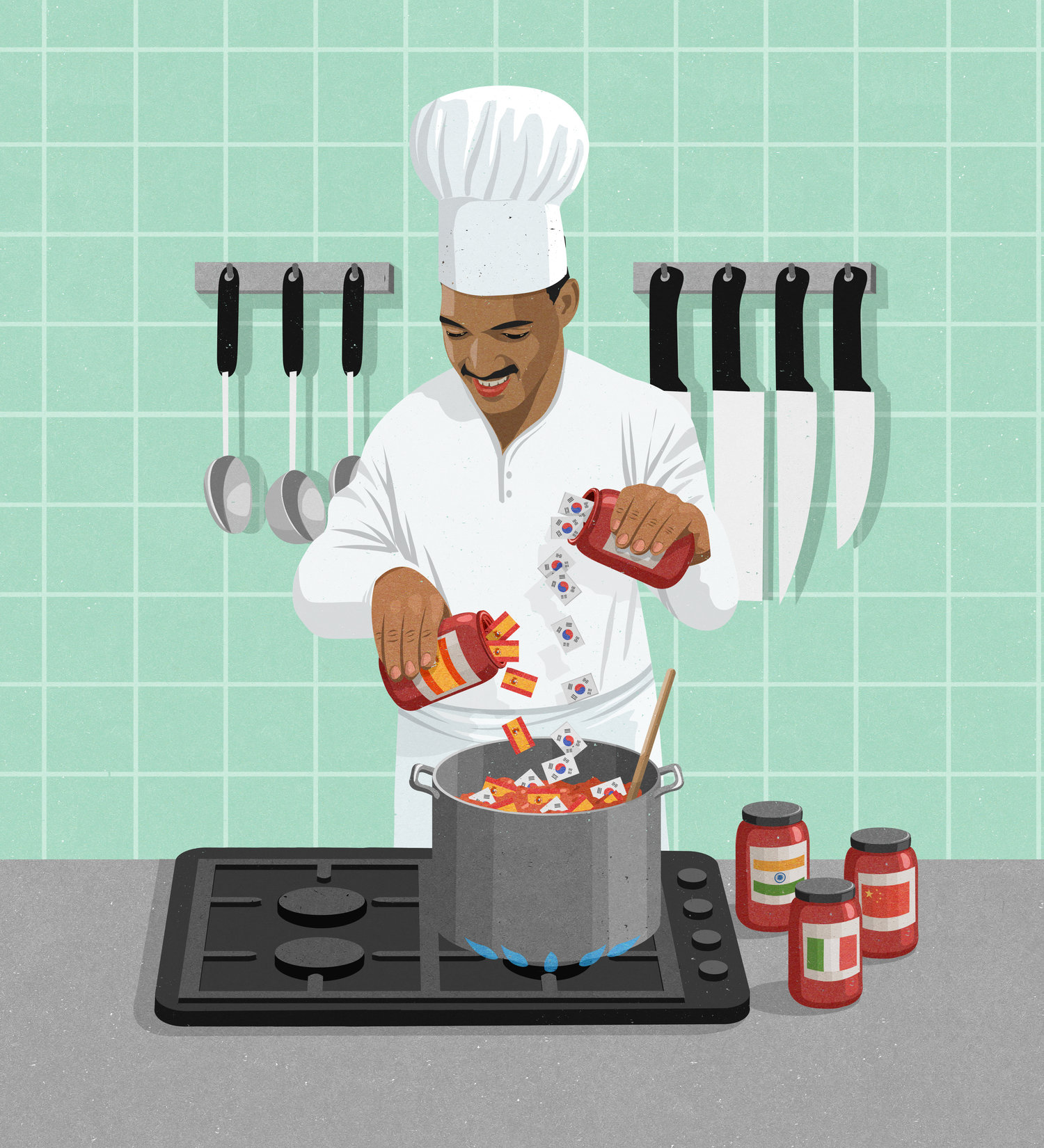TALK OF CULTURAL APPROPRIATION HAS REACHED RESTAURANT KITCHENS. BUT IN FOOD CULTURE, WHERE SWAPPING RECIPES AND BORROWING INSPIRATION IS INTEGRAL, IS APPROPRIATION ACTUALLY POSSIBLE?
WRITTEN BY REBECCA TUCKER
ILLUSTRATION BY JOHN HOLCROFT
Earlier this year, Montreal-born graduate student Nicolas Fabien-Ouellet presented a paper at Ryerson University’s annual Congress of the Humanities and Social Sciences. The paper, titled “Poutine Dynamics,” had a compelling, if somewhat odd and unlikely, thesis: that claiming poutine as part of the canon of Canadian cuisine constitutes a form of cultural appropriation.
Fabien-Ouellet’s argument — which made national headlines in Canada ahead of his paper’s presentation in June — is that poutine is a Québécois invention, and one that has been routinely mocked by Anglo-Canadians as downmarket and unrefined. However, since the recent ascendancy of Canadian cuisine, English speakers have glommed on to poutine as a part of their heritage, thereby erasing its history as a Francophone dish and appropriating it as part of the English-Canadian culinary repertoire.
“The dish should be, ideally, labelled explicitly as a Québécois dish,” Fabien-Ouellet wrote in the paper, “and not a Canadian one to further underscore the cultural context to which it actually belongs.”
That same week, south of the border, a Portland restaurant called Kooks Burrito was under fire for having stolen tortilla recipes on a road trip to Mexico. The restaurant’s two proprietors — both white women — have since shut down their eatery, as accusations of cultural appropriation proved too damning for business.
Cultural appropriation is on the tip of many pundits’ and activists’ tongues these days, and rightly so: discussions surrounding race, racism, and identity politics have become increasingly nuanced, and increasingly mainstream. The relatively new widespread understanding of the term, which means “the unacknowledged or inappropriate adoption of customs, practices, ideas, etc. of one people or society by members of another and typically more dominant people or society,” is the reason why the Osheaga music festival in Montreal recently banned the wearing of Indigenous headdresses as “festival apparel.” It was also behind a kerfuffle in May that saw several prominent Canadian media figures under fire for their tweeting about a fictional literary “appropriation prize.” Barely a month earlier, non-Indigenous Canadian artist Amanda PL cancelled a public exhibition over outcry that her work borrowed heavily from the style of Anishinaabe artist, Norval Morrisseau.
But while there are some clear-cut rules governing what is and isn’t cultural appropriation, the line can get blurred. When does appreciation become appropriation? Who is allowed to borrow what? And when — and who — makes this decision? What’s the line between inspiration and theft?
And considering the poutine paper and burrito imbroglio, how do these questions apply to a discipline where the sharing, borrowing, swapping, and bending of ideas and traditions is utterly integral: food?
Dan Pashman is the host of The Sporkful, a U.S. podcast focusing on food politics. In 2016, the podcast ran a series called “Other People’s Food,” which focused on questions of cultural appropriation in professional restaurant kitchens, as well as in food media (the impetus for the series was Pashman’s idea of reinventing the traditional stone bowl used to cook and serve the Korean dish bi bim bap as something resembling a bundt pan, in order to optimize the surface area and get more crispy rice — and the backlash this idea received).
“I think that one of the big takeaways that I learned is that the question of where do you draw the line is a fine question to ask, but I feel like it’s not the most productive question,” Pashman says in a phone interview. “The question always becomes: is it racist or not? Which side do you stand on? A better question to ask is, if you try really, really hard to put yourself in another person’s shoes, and when you do, can you see it from their point of view? Can you understand how someone else might see it like this?”
“THE QUESTION ALWAYS BECOMES: IS IT RACIST OR NOT? WHICH SIDE DO YOU STAND ON? A BETTER QUESTION TO ASK IS, IF YOU TRY REALLY, REALLY HARD TO PUT YOURSELF IN ANOTHER PERSON’S SHOES, AND WHEN YOU DO, CAN YOU SEE IT FROM THEIR POINT OF VIEW? CAN YOU UNDERSTAND HOW SOMEONE ELSE MIGHT SEE IT LIKE THIS?”
Pashman is careful to note that, in conversations surrounding the cultural appropriation of food, his own identity — he’s white — prevents him from being the guy who can decide what’s right and what’s wrong; he’s just asking the questions. And they’re big questions that have long been absent in discussions surrounding identity politics in restaurant kitchens (if those questions themselves have even existed): just look at Rick Bayless, the star U.S. chef who’s made his name as an authority on Mexican cuisine. Bayless has spent time living in Mexico, and he regularly sends his kitchen staff to the country to update their skillsets and gather inspiration. And this is important: in kitchens, both professional and at home, the exchange of ingredients, techniques, and recipes is an integral part of not only learning how to cook, but learning about a different culture.
“I think it’s great for humanity to share our culture, [which] allows for the continuous refining and development of culture,” says Ibram X. Kendi, a professor at American University and author of the National Book Award-winning Stamped from the Beginning: The Definitive History of Racist Ideas in America. “What I do see a problem with is when people seek to brand themselves as authentically part of a particular culture when they’re not.”
Which is not to say that’s what Bayless — or any other chefs, like Grant van Gameren, who’s opened Mexican, Spanish and now Eastern European restaurants in Toronto; or Antonio Park, the Korean chef raised in Argentina who cooks Japanese food in Montreal — is doing. But authenticity is tricky, depending on how granular you want to get with the concept, as far as food is concerned. It’s not likely that trend-focused foodies are questioning the authenticity of sushi burritos, butter chicken perogies or fusion cuisine, like the Italian-Japanese dishes at award-winning Kissa Tanto, in Vancouver — these are examples of the types of free exchange of ideas, ingredients, and cooking styles that lead to inspiration and innovation, for better (Kissa Tanto) or worse (sushi burritos).
For Mijune Pak, the food blogger and Top Chef Canada judge, it boils down to questions of authenticity, which she suggests can be impossible to answer definitively, considering the frequency with which ingredients and recipes have been swapped, remixed, and reinterpreted throughout history. “Ever since Noma started pushing the locavore thing, we’re trying to recreate these traditional recipes with local products,” she says. “But then it’s kind of like, well, okay, we’re making homemade burrata, but you can’t technically recreate that without the milk and dairy from [North American] cows. People say things like, ‘don’t say it’s inauthentic, because I got it from a Korean guy’ all the time. Who’s to say what’s authentic or what’s not? Recipes are created. They’re flexible.”
But when the interpretation of a white chef is the most significant exposure that many people have to an ethnic style of food — like Bayless’ spin on Mexican food, for instance — and when they, in turn, associate this spin on Mexican food with Mexican food at large, is something getting lost in translation?
“WHEN THE INTERPRETATION OF A WHITE CHEF IS THE MOST SIGNIFICANT EXPOSURE THAT MANY PEOPLE HAVE TO AN ETHNIC STYLE OF FOOD — LIKE BAYLESS’ SPIN ON MEXICAN FOOD, FOR INSTANCE — AND WHEN THEY, IN TURN, ASSOCIATE THIS SPIN ON MEXICAN FOOD WITH MEXICAN FOOD AT LARGE, IS SOMETHING GETTING LOST IN TRANSLATION?”
“One of the things that I’ve noticed is that restaurants that serve food from the cultures of people of colour, sometimes gear their food towards white audiences,” Kendi says. “You have African Americans going to a soul food spot expecting a particular type of seasoning, and they don’t receive that because it’s more geared towards white audiences. The irony here is that it allows white Americans to imagine that they’re engaging in this authentically ethnic experience. I think that this is creating a false diversity of food.”
It’s also a question of economic mobility. When Kooks Burrito came under fire for its appropriation of burrito recipes, the simmering undercurrent of the controversy wasn’t simply that two white women were making non-white food; rather, it was that two women who had easy access to funding were capitalizing on the cuisine of a traditionally marginalized community. As with all conversations surrounding questions of cultural appropriation, the issue when it comes to food is a matter of power. “On the one hand, recipes are meant to be shared,” says Kendi, “but simultaneously, people are supposed to benefit equally from the sharing. Appropriation becomes dangerous when one person has a recipe and they’re able to brand themselves on that recipe and make lots of cash, where another person has the same recipe and they’re not able to make the same kind of money.”
Pashman agrees. To the people interviewed for his Sporkful series on cultural appropriation, he says, “some of the red flags were when another culture’s food is being used by someone who doesn’t seem to know anything about it. The second red flag was, is this person going off and making a ton of money on something that is essentially created by someone else?”
And when members of minority communities, whose food has historically been sold for less, marketed as lesser, and mocked as odd and unusual (ask any child of immigrants to tell you what it was like to open their packed lunch during primary school), see this food “elevated” by white chefs — and celebrated by the peers of those chefs — the whiff of colonialism can sting. “[Chefs] can claim legitimacy,” Kendi says, but “they need to recognize that those products still reside in the cultural realm where [they] found them.”
But for die-hard gourmands and chefs for whom global inspiration is integral to both creative and professional survival, these questions might begin to set off quiet alarm bells. Will chefs and other culinary creatives be increasingly pressured to stay in a specific cultural lane, and therefore pushed away from seeking inspiration that deviates from his or her ethnic background?
It’s unlikely. Food is a stand-in for identity, so it makes sense that we’re protective of it — we want to safeguard the recipes, methodologies, and ingredients of our respective backgrounds, because these things say something important about who we are. But it’s for this same reason that we share food: it’s often the easiest, most nuanced, most thorough way to introduce ourselves — and our cultures — to others.
“I’ve come to believe that you can learn everything you need to know about a person by asking them what they like to eat and how they like to eat it,” says Pashman. “Everyone eats. And increasingly, as different [cultural cuisines] become more readily available in North America, these foods that once seemed unfamiliar are common. So they offer something of a shared reference point. There’s a lot about other people’s experiences that may be hard … but food is universal.”








